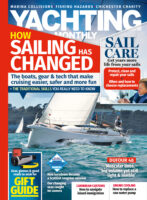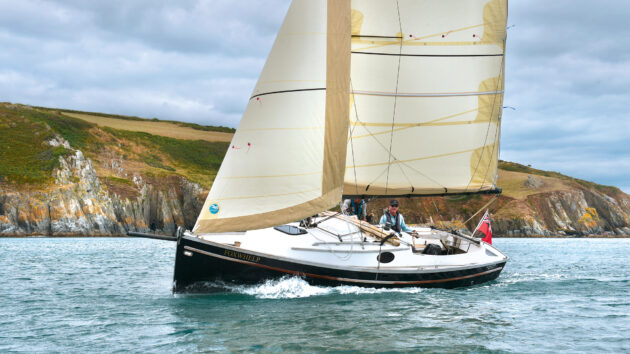The BayCruiser 23 is a water ballast trailer-sailer that gives you two boats for the price of one, according to its builders Swallow Yachts
The BayCruiser 23 review: Why this water ballast trailer-sailer is the perfect weekender
It started with a burp. Well, in a manner of speaking. There was a strange moment soon after the start of my test of the BayCruiser 23 when owner Mark Darley furled the genoa, eased the main and stopped the boat.
As I watched from the camera boat, he walked forward and stood in the bow for several minutes, before returning to the cockpit and setting the sails again. It turned out the wind was too strong and he had decided to fill the water ballast tanks to give the boat more stability. Having someone stand in the bow helps to ‘burp’ the forward tank and ensure the system is completely full, to prevent the water slopping around.
A few seconds later, Mark messaged me: ‘OK, fully ballasted. Different boat.’
This really gets to the nub of the boat’s success and the reason Mark chose it over any number of other trailer-sailers he could have bought: the versatility of water ballast means you can have a lightweight speedster when you want it or you can slow things down and go into cruising mode by simply opening the seacocks and letting the water in.
Or, as builders Swallow Yachts put it: you get two boats for the price of one. Not only that, but it means the boat is light enough to be easily trailered without burning a tonne of fuel (the boat weighs just 1,870lb/850kg empty).

Mark wanted the benefits of ballast without having to tow a heavy keel. Photo: Nic Compton
On top of all that, the BayCruiser 23 is as pretty as a picture – a cunning blend of new and old, classic and modern. The BayCruiser 23 is by no means the first boat Mark has owned, and he has had a long and varied boating life to arrive at the conclusion that this was the boat for him.
It started with Isle of Wight Scows and Cadets on Keyhaven River, followed by International 420s out of Lymington, followed by crewing jobs on a variety of yachts up and down the South Coast. Just before he was going to take his Law degree at Reading University, someone he met in a pub offered him a job on board the Camper & Nicholson ketch Lord Jim. And so, with barely a second thought, he abandoned his academic career to spend three-and-a-half years sailing the world.
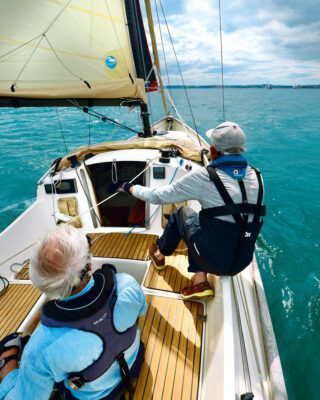
With full ballast tanks she sails steady and straight. Photo: Nic Compton
American Adventures
He eventually fetched up in America (with his American wife Susanne) where he carved out a highly successful career as architectural photographer, first in New York then in San Francisco. But his love of sailing never waned. His first trailer-sailer after his children had flown the nest was a 16ft Salterns Tela, a pretty-as-you-like traditional gaffer which he exported to the USA and sailed happily on San Francisco Bay and Tomales Bay for several years.
That was followed by a Salterns Memory 19 which he sailed first out of Salcombe and then the River Dart. He had by then spotted the Swallow Yachts range of trailer-sailers and, to help him decide which model would suit him best, he attended the annual Swallow Yachts Rally in Mylor, Cornwall.
He tested almost every boat there but ended up going for the only one he hadn’t sailed: the wooden version of the BayRaider 20, which he reasoned was 33 per cent lighter than the fibreglass version and had a chine which would help it sail better to windward.
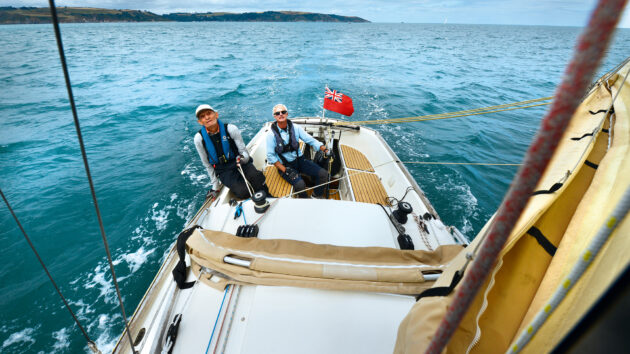
Mark always keeps the mainsheet in hand, ready to luff up if required. Photo: Nic Compton
He travelled extensively with Pippin, including trips to Spain, Sardinia and Ireland with Susanne, and competing in two Caledonian Raids with one of his brothers as crew. Eventually, it was the lack of built-in accommodation that drove him to seek a different boat, this time GRP.
‘I wanted to be able to cruise in more comfort with my wife – to live on board rather than camping under a tent,’ he says. ‘I wanted the option of having ballast without having to drag around half a ton of lead, especially at a time when we are all trying to be more environmentally friendly. This boat isn’t quite as easy to get on a trailer as a 325kg boat (the weight of the wooden BayRaider 20), but it’s pretty simple.’
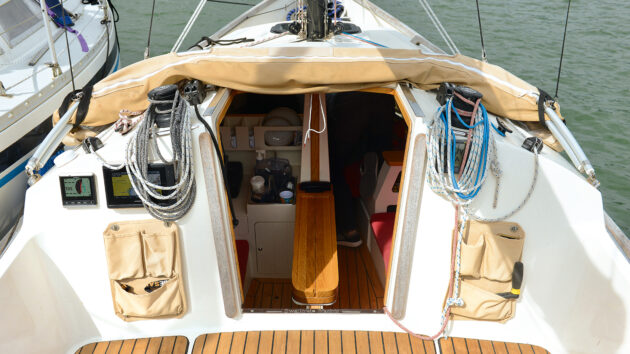
Easy step down into the cabin. Photo: Nic Compton
Design Evolution
The BayCruiser range evolved out of a design Swallow Yachts MD Matt Newland submitted for a Classic Boat design competition back in 2006. Competition judge Nigel Irens described his design for a 21ft 10in lightweight camper-cruiser (with water ballast) as a ‘modern classic’ and a ‘modern version of the Drascombe lugger’.
That design became the BayRaider 20, which was Swallow Yachts’ first successful production boat, the company having built mainly wooden boats and kits before then. The BayRaider 20 was followed by the BayCruiser 20, a beamier, more comfortable boat fitted with a small cabin, which soon grew into the BayCruiser 23, which boasted four berths and a more streamlined design. The boat quickly acquired a devoted following, with nearly 100 boats built in the past 12 years.
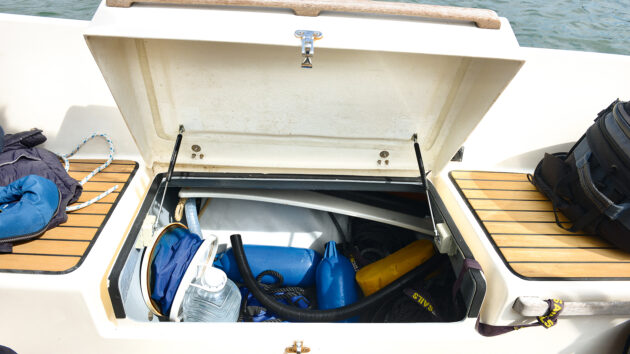
The roomy cockpit has a spacious locker. Photo: Nic Compton
Options and Upgrades
Mark bought Foxwhelp (named after a favourite cider apple) new and, as he intended to sail the boat singlehanded at least some of the time, he made several changes to the original spec – several at the recommendation of Rob Johnstone, who sailed his BayCruiser 23 around the British Isles (mostly singlehanded) in 2012-14.
Rob suggested adding a couple of D-rings and life lines to clip onto, which Mark did, and also adding a pushpit and pulpit, which Mark didn’t do, on the basis that he wasn’t planning to undertake any truly offshore voyages. Another change was to fit a second lithium battery to power a large fridge and autopilot. ‘I told Matt I wanted to be able to never go into a marina, to be completely self-sufficient,’ explains Mark.
Article continues below…
The two batteries give a combined power of 100Ah, recharged through two small solar panels fitted on the aft deck, plus one large solar panel which is stowed down below until needed. Mark also fitted some extra navigation equipment to enable him to sail further afield with impunity, including chartplotter, wind indicator and built-in VHF. In practice, he uses a combination of chartplotter, iPad and paper charts to navigate.
But perhaps the biggest changes were to the boat’s carbon rig. Mark ordered the sails from Highwater Sails in Plymouth who recommended fitting Harken ‘battcar’ sail slides with roller bearings, to make the sail easier to lower and to reef. ‘They were expensive, but it’s important to be able to douse the sail quickly when you’re singlehanding,’ says Mark.
They also suggested a slightly more ‘modern’ rig with fuller roach to give extra power in light air. Mark also requested an extra line of reefing points, so Foxwhelp now has three. Last but not least, he opted for a roller furling asymmetric spinnaker, instead of the standard bagged version.
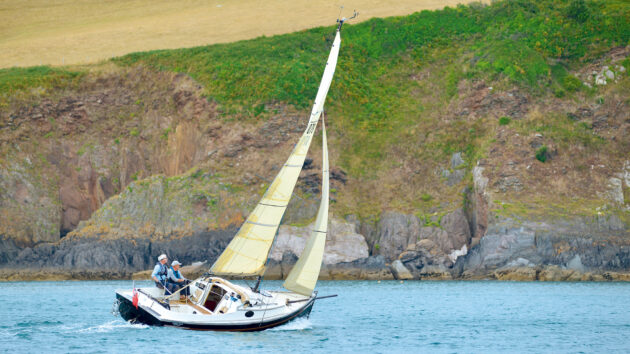
Mark has sailed Foxwhelp as far afield as Scotland, Cornwall and Brittany. Photo: Nic Compton
Under Sail
I’ve sailed on a couple of BayCruiser 23s in the past and been extremely impressed with the compact yet comfortable accommodation, as well as its nimble performance under sail. But you do have to treat that water ballast with respect. Without it, the boat performs like a dinghy, responding to the slightest breeze and spinning around the daggerboard on a sixpence.
‘In light airs, with no ballast under the symmetric spinnaker, she can sail at 70° to the apparent wind,’ says Mark. ‘In five knots of wind, she’ll be doing five knots, and will sail past 36-footers. I seldom use the outboard, unless the wind is less than four knots and I have to be somewhere on time. If there’s four knots of wind, I can use it.’
The downside is that, if you do get caught in a sudden gust without water ballast, she’ll heel over dramatically. So you have to sail her like a dinghy – mainsheet in hand and ready to luff up at a moment’s notice.
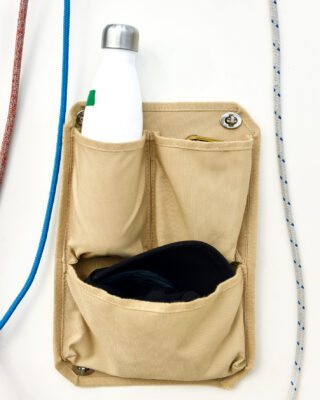
Simple but handy stowage solution. Photo: Nic Compton
It’s not insignificant that during the Swallow Yachts regatta, Matt insists on all the participants filling their boats’ ballast tanks if things start to get hairy. Once the ballast tanks are full, as Mark puts, it’s a different boat; much steadier, much less tippy. Though you’d still be advised to keep the mainsheet in hand and be ready to luff up in windy weather.
We had perfect conditions for our test sail off Dartmouth, with a steady 14 knots coming off the land and 18-knot gusts shooting down the valleys. Foxwhelp lapped it up and, with a flat calm sea, clipped along at a steady five and a half knots. Despite the gusty conditions, Mark had no hesitation in setting the spinnaker, and soon the boat was ripping along at seven knots.
He has experienced far more extreme conditions on this boat, sailing in 40-knot winds with triple reefed main and furled genoa, and said that Foxwhelp felt ‘perfectly safe’.
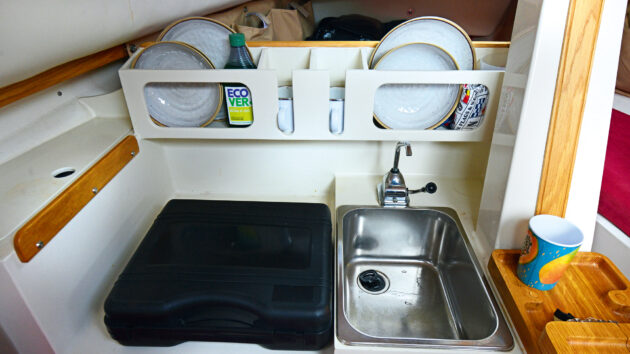
Tidy, well thought-out small galley amidships. Photo: Nic Compton
Creek Crawling
There are other reasons why Mark chose to buy this compact 23-footer, rather than any of the much larger second-hand yachts he could have bought for rather less money, not least her draft. With empty ballast tanks, the BayCruiser 23 draws just 12in (30cm).
‘I like sailing in “thin water’,’’ he says, quoting an expression coined by Roger Barnes, author of The Dinghy Cruising Companion. ‘I like going up creeks and estuaries, especially in July and August, when you see big boats motoring from one marina to the next.
With these boats, you sail past town, past the marinas, past the moorings, and just keep going until you find 2ft water and, as long as it’s got a flattish bottom, park the boat and dry out. I like to get away from the crowds and moor in beautiful places, instead of being in a boat parking lot.’
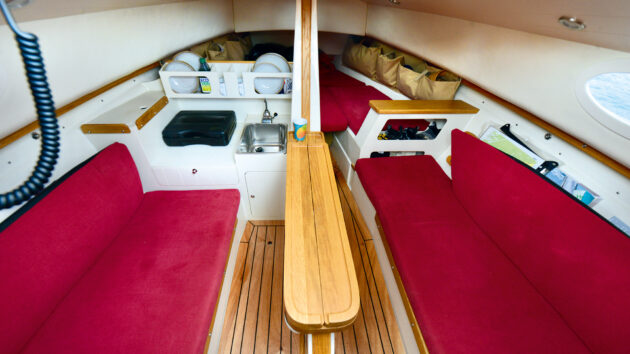
Two full-length berths in the saloon area. Photo: Nic Compton
It’s certainly a very different kind of sailing than those of us wedded to our comfortable cruising yachts are used to. ‘Big cruising boats tend to stay in the same water until you’ve got enough time to move to somewhere else,’ says Mark.
‘With a trailer-sailer you can visit different waters all time. Trailer-sailer owners live all over the place, often far away from the coast – and they are inquisitive people. If they wonder what it’s like in Holland, they just hitch the boat up and go. It gives tremendous flexibility in being able to cruise new waters, and it brings together a great community of people.’
True to his word, since buying Foxwhelp in 2022, Mark has taken her to several destinations away from his home patch in Devon, including up the River Rance in Brittany, around the Gulf of Morbihan, as well as cruises in Scotland and Cornwall.
Although the boat is perfectly capable of crossing the Channel, he usually takes it on the trailer by ferry to France to save time. One of the most noticeable features of the BayCruiser 23, which frankly takes a bit of getting used to, is the big outboard well in the stern of the cockpit.
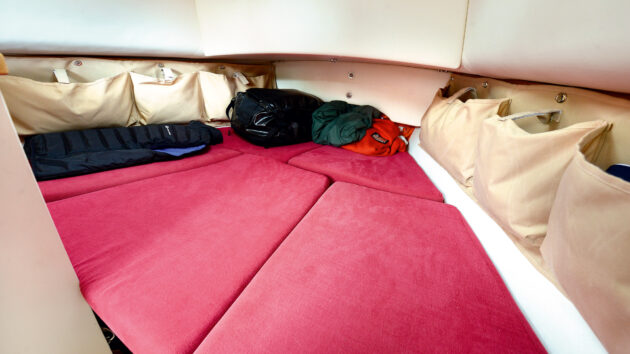
A wide double berth forward. Photo: Nic Compton
This is designed to allow the outboard to be hinged completely clear of the water which means you end up with a huge hole in the back of the boat. Mylar flaps cover the slot and reduce the drag, although some owners have retrofitted hinged plywood flaps to fully close the aperture when not in use.
Far from being put off by that big hole, Mark points out that it’s ‘probably the best drained cockpit of any boat this size!’ In practice, a small amount of water does creep into the cockpit when the boat heels in a gust with full ballast tanks, but it quickly drains as soon as it rights itself.
Below decks, the boat’s wide beam (more than a third her length) gives a surprisingly spacious feel, with a wide double berth forward (though the feet area looked a bit tight), two full length berths with infills in the saloon, and a proper little galley. She also has the limitations of all trailer-sailers – lack of standing headroom, no enclosed heads (Mark has a compost loo instead of the standard chemical loo which works very well, he says), and limited storage.
Baycruiser 23 specifications
DESIGNER: Matthew Newland
YEARS BUILT: 2013-present
LOA: 22ft 11in/6.98m
LWL: ft/m
BEAM: 8ft/2.36m
DRAFT: 1ft/0.3m (c/b up) 4ft 11in/1.5m (down)
DISPLACEMENT: 1,870lbs/850kg
WATER BALLAST: 992lbs/450kg
SAIL AREA: 260ft2/24.2m2
PRICE: £ 40,000-60,000
Enjoyed reading this?
A subscription to Yachting Monthly magazine costs around 40% less than the cover price, so you can save money compared to buying single issues.
Print and digital editions are available through Magazines Direct – where you can also find the latest deals.
YM is packed with information to help you get the most from your time on the water.
-
-
- Take your seamanship to the next level with tips, advice and skills from our experts
- Impartial in-depth reviews of the latest yachts and equipment
- Cruising guides to help you reach those dream destinations
-
Follow us on Facebook, Twitter and Instagram.
Note: We may earn a commission when you buy through links on our site, at no extra cost to you. This doesn’t affect our editorial independence.
Verdict
If a trailer-sailer is your thing, then there’s really not much to dislike about the BayCruiser 23. It’s a carefully thought-through design from a designer, Matt Newland, who has been brought up around these boats and lived the business for most of his life. The boats are well built, with lots of nice joinery touches both on deck and down below. The BayCruiser 23 may not slice to windward as well as a deep-keeler, such as Mark’s previous Salterns Tela, but in most other conditions she’ll perform better and faster. Getting your hands on one at a reasonable price might be the only issue. New boats are still being built, but there’s still a relatively small pool of second-hand boats available, meaning they hold their value extremely well. Lucky is the man (or woman) whose needs are fulfilled by such a relatively simple boat and yet who can afford a BayCruiser 23.

